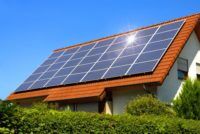If you live in South Australia and have a solar system on your roof, there is no longer a guaranteed minimum rate for the excess solar that you send into the grid unless you are on the state’s Premium FiT program (which expires in 2028).
The Essential Services Commission of South Australia (ESCOSA) made the determination to eliminate the minimum retailer feed-in tariff (R-FiT) towards the end of 2016, and the change is in effect from the beginning of this year.
In a nutshell, this means that South Australia has followed suit with virtually every other state on Australia’s eastern seaboard (including NSW and Queensland) in leaving solar feed-in rates up to ‘retailer competition’. In these states, solar feed-in rates are now set voluntarily by electricity retailers, and customers need to shop around to find a rate they are happy with from a company that they trust.
The implications of the removal of the R-FiT are likely to be relatively small, and ESCOSA even says that it may consider reinstating a minimum rate if the market bears out unfair results for solar system owners. Nevertheless, there are some points for SA residents who have solar or are considering having solar panels installed to keep in mind. We’ve broken them down here.
 What does the end of the R-FiT mean for South Australia’s solar homes?
What does the end of the R-FiT mean for South Australia’s solar homes?
The impact that this change will have on you depends on your situation, whether or not you are a beneficiary of the state’s Premium FiT (closed to new applicants on 30 Sept 2011), and whether or not you already have solar panels on your roof.
You already have solar panels:
- Situation A: You are one of the lucky recipients of SA’s Premium Feed-in Tariff, which closed to new applicants on 30 September, 2011. Beneficiaries of this program receive 44c per kilowatt-hour (44c/kWh) for the solar energy that they send into the grid. The Premium Feed-in Tariff payments will continue until 2028 or until the system is augmented (e.g. addition of new panels or batteries).
- Recommendation: The 44c/kWh legacy rate is still one of the highest in the nation, and even without the R-FiT. While your access to the Premium FiT should guarantee you handsome returns regardless, you may still want to focus your attention on investigating offers from multiple electricity retailers, as other aspects of their plans may differ – and some may even offer a bit more.
- Situation B: You do not have access to a state-sponsored solar feed-in rate (i.e. every other solar home in South Australia). Until the end of last year, you received at least the 6.8c/kWh rate mandated by ESCOSA, but now you’re not sure what your rate will be.
- Recommendation: Different retailers will offer different feed-in rates with different plans. Do your research and make sure you’ve decided on a rate, plan and retailer that you are happy with.
You’re thinking about getting solar panels (and batteries):
The end of a mandatory minimum solar feed-in rate for South Australia does little to change the sunny prospects of going solar in the state. The last rate mandated by ESCOSA was 6.8c/kWh, which was comparable to the average rate long offered voluntarily by retailers in New South Wales and Queensland.
Despite these low rates, households across the country have continued to install solar in droves. In South Australia, over one out of three households already have solar panels installed, according to the APVI. Solar remains a viable and attractive investment in the state for two main reasons:
- Solar panel systems are affordable; and
- Grid electricity prices are quite high in South Australia (due largely to high wholesale electricity prices).
Having a home solar system installed allows a South Australian home to generate a portion of their own electricity. The more solar energy they consume themselves, the less they need to purchase. This translates into lower usage charges on their electricity bills.
Recommendations:
- Determine whether solar is right for your home;
- Know what to expect from going solar (and possibly getting batteries) and shop around for a good deal from an installer that you trust; and
- Decide on electricity retailer that offers a good solar deal – which doesn’t always mean the highest feed-in tariff.
Get a free comparison of quotes from solar & battery providers in your area
© 2017 Solar Choice Pty Ltd
- Solar Panel Costs: Solar Choice Price Index | April 2025 - 1 April, 2025
- Solar Panels For Homes – All You Need to Know About Solar Systems - 18 March, 2025
- Best NSW Solar Feed-In Tariffs - 17 March, 2025